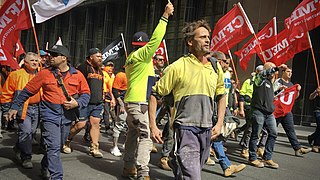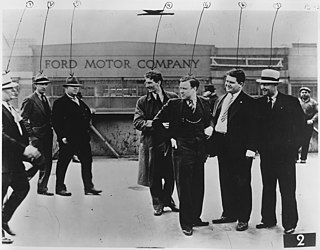The Mohawk Valley formula is a plan for strikebreaking purportedly written by the president of the Remington Rand company James Rand, Jr. around the time of the Remington Rand strike at Ilion, New York in 1936/37.
The plan includes discrediting union leaders, frightening the public with the threat of violence, using local police and vigilantes to intimidate strikers, forming associations of "loyal employees" to influence public debate, fortifying workplaces, employing large numbers of replacement workers, and threatening to close the plant if work is not resumed. [1] [2]
The Remington Rand company did indeed ruthlessly suppress the strikes, as documented in a ruling by the National Labor Relations Board, and the plan has been accepted as a guide to the methods that were used. At least one source names the strikebreaker Pearl Bergoff and his so-called "Bergoff technique" as the origin of the formula. [3] Rand and Bergoff were both indicted by the same federal grand jury for their roles in the Remington Rand strike.
Noam Chomsky has described the formula as the result of business owners' trend away from violent strikebreaking to a "scientific" approach based on propaganda. An essential feature of this approach is the identification of the management's interests with "Americanism", while labor activism is portrayed as the work of un-American outsiders. Workers are thus persuaded to turn against the activists and toward management to demonstrate their patriotism. [4] [5]
The following is the text of the Mohawk Valley formula as quoted in the labor press:
A similar, although more nuanced and longer, version was published in The Nation in 1937. [1]

Manufacturing Consent: The Political Economy of the Mass Media is a 1988 book by Edward S. Herman and Noam Chomsky. It argues that the mass communication media of the U.S. "are effective and powerful ideological institutions that carry out a system-supportive propaganda function, by reliance on market forces, internalized assumptions, and self-censorship, and without overt coercion", by means of the propaganda model of communication. The title refers to consent of the governed, and derives from the phrase "the manufacture of consent" used by Walter Lippmann in Public Opinion (1922). The book was honored with the Orwell Award.

Strike action, also called labor strike, labour strike and industrial action in British English, or simply strike, is a work stoppage caused by the mass refusal of employees to work. A strike usually takes place in response to employee grievances. Strikes became common during the Industrial Revolution, when mass labor became important in factories and mines. As striking became a more common practice, governments were often pushed to act. When government intervention occurred, it was rarely neutral or amicable. Early strikes were often deemed unlawful conspiracies or anti-competitive cartel action and many were subject to massive legal repression by state police, federal military power, and federal courts. Many Western nations legalized striking under certain conditions in the late 19th and early 20th centuries.

Remington Rand, Inc. was an early American business machine manufacturer, originally a typewriter manufacturer and in a later incarnation the manufacturer of the UNIVAC line of mainframe computers. Formed in 1927 following a merger, Remington Rand was a diversified conglomerate making other office equipment, electric shavers, etc. The Remington Rand Building at 315 Park Avenue South in New York City is a 20-floor skyscraper completed in 1911. After 1955, Remington Rand had a long series of mergers and acquisitions that eventually resulted in the formation of Unisys.

The Battle of the Overpass was an attack by Ford Motor Company against the United Auto Workers (UAW) on May 26, 1937, at the River Rouge complex in Dearborn, Michigan. The UAW had recently organized workers at Ford's competitors, and planned to hand out leaflets at an overpass leading to the plant's main gate in view of many of the 90,000 employees. Before the UAW organizers could begin, they were attacked by Ford's "quasi-military" security service and the Dearborn police.

A strikebreaker is a person who works despite a strike. Strikebreakers are usually individuals who were not employed by the company before the trade union dispute but hired after or during the strike to keep the organization running. Strikebreakers may also refer to workers who cross picket lines to work.

The Great Railroad Strike of 1922, or the Railway Shopmen's Strike, was a nationwide strike of railroad workers in the United States. Launched on July 1, 1922 by seven of the sixteen extant railroad labor organizations, the strike continued into August before collapsing. A sweeping judicial injunction by Judge James Herbert Wilkerson effectively ended the strike on September 1, 1922.
In the United States Senate, the La Follette Civil Liberties Committee, or more formally, Committee on Education and Labor, Subcommittee Investigating Violations of Free Speech and the Rights of Labor (1936–1941), began as an inquiry into a National Labor Relations Board (NLRB) investigation of methods used by employers in certain industries to avoid collective bargaining with unions.

Union busting is a range of activities undertaken to disrupt or weaken the power of trade unions or their attempts to grow their membership in a workplace.

The Great Steel Strike of 1919 was an attempt by the American Federation of Labor to organize the leading company, United States Steel, in the American steel industry. The AFL formed a coalition of 24 unions, all of which had grown rapidly during World War I. In the lead role would be the Amalgamated Association of Iron, Steel and Tin Workers (AA) with a five-member steering committee. The strike began on September 22, 1919, and finally collapsed on January 8, 1920. The opposition led by Elbert H. Gary, president of U.S. Steel had triumphed.
The Westmoreland County coal strike of 1910–1911, or the Westmoreland coal miners' strike, was a strike by coal miners represented by the United Mine Workers of America. The strike is also known as the Slovak Strike because about 70 percent of the miners were Slovak immigrants. It began in Westmoreland County, Pennsylvania, on March 9, 1910, and ended on July 1, 1911. At its height, the strike encompassed 65 mines and 15,000 coal miners. Sixteen people were killed during the strike, nearly all of them striking miners or members of their families. The strike ended in defeat for the union.
The Remington Rand strike of 1936–1937 was a strike by a federal union affiliated with the American Federation of Labor (AFL) against the Remington Rand company. The strike began in May 1936 and ended in April 1937, although the strike settlement would not be fully implemented until mid-1940.
Labor spying in the United States had involved people recruited or employed for the purpose of gathering intelligence, committing sabotage, sowing dissent, or engaging in other similar activities, in the context of an employer/labor organization relationship. Spying by companies on union activities has been illegal in the United States since the National Labor Relations Act of 1935. However, non-union monitoring of employee activities while at work is perfectly legal and, according to the American Management Association, nearly 80% of major US companies actively monitor their employees.

The 99-day Ford strike of 1945 took place in Windsor, Ontario, Canada, from September 12, 1945, to December 19, 1945. Although several union demands were contentious issues, the two main demands of the UAW Local 200 were "union shop and checkoff," which became a rallying cry for the strikers. Negotiations for a new contract had spanned 18 months and officially ended with the exodus of Ford workers at 10 a.m. on the morning of September 12. The strike included picketing and eventually led to a two-day blockade of vehicles surrounding the Ford plant on November 5.

James Henry Rand Jr. was an American industrialist who revolutionized the business record industry. He founded American Kardex, an office equipment and office supplies firm which later merged with his father's company, the Rand Ledger Corporation. Rand later bought out and merged with several other companies, notably the Remington Typewriter Company, to form Remington Rand. In 1955, Rand merged his corporation with the Sperry Corporation to form Sperry-Rand, one of the earliest and largest computer manufacturing companies in the United States.

The history of union busting in the United States dates back to the Industrial Revolution in the 19th century. The Industrial Revolution produced a rapid expansion in factories and manufacturing capabilities. As workers moved from farms to factories, mines and other hard labor, they faced harsh working conditions such as long hours, low pay and health risks. Children and women worked in factories and generally received lower pay than men. The government did little to limit these conditions. Labor movements in the industrialized world developed and lobbied for better rights and safer conditions. Shaped by wars, depressions, government policies, judicial rulings, and global competition, the early years of the battleground between unions and management were adversarial and often identified with aggressive hostility. Contemporary opposition to trade unions known as union busting started in the 1940s, and continues to present challenges to the labor movement. Union busting is a term used by labor organizations and trade unions to describe the activities that may be undertaken by employers, their proxies, workers and in certain instances states and governments usually triggered by events such as picketing, card check, worker organizing, and strike actions. Labor legislation has changed the nature of union busting, as well as the organizing tactics that labor organizations commonly use.

The Indianapolis streetcar strike of 1913 and the subsequent police mutiny and riots was a civil conflict in Indianapolis, Indiana. The events began as a workers strike by the union employees of the Indianapolis Traction & Terminal Company and their allies on Halloween night, October 31, 1913. The company was responsible for public transportation in Indianapolis, the capital city and transportation hub of the U.S. state of Indiana. The unionization effort was being organized by the Amalgamated Street Railway Employees of America who had successfully enforced strikes in other major United States cities. Company management suppressed the initial attempt by some of its employees to unionize and rejected an offer of mediation by the United States Department of Labor, which led to a rapid rise in tensions, and ultimately the strike. Government response to the strike was politically charged, as the strike began during the week leading up to public elections. The strike effectively shut down mass transit in the city and caused severe interruptions of statewide rail transportation and the 1913 city elections.

Anti-union violence is physical force intended to harm union officials, union organizers, union members, union sympathizers, or their families. It is most commonly used either during union organizing efforts, or during strikes. The aim most often is to prevent a union from forming, to destroy an existing union, or to reduce the effectiveness of a union or a particular strike action. If strikers prevent people or goods to enter or leave a workplace, violence may be used to allow people and goods to pass the picket line.
Pearl Louis Bergoff was an American strikebreaker noted for violent tactics from the early 1900s through the 1930s.

The Bayonne refinery strikes of 1915–1916 were labor actions of refinery workers in Bayonne, New Jersey, mostly Polish-Americans who struck Standard Oil of New Jersey and Tidewater Petroleum plants on Constable Hook beginning in mid-July 1915.

The Little Steel strike was a 1937 labor strike by the Congress of Industrial Organizations (CIO) and its branch the Steel Workers Organizing Committee (SWOC), against a number of smaller steel producing companies, principally Republic Steel, Inland Steel, and Youngstown Sheet and Tube Company. The strike affected a total of thirty different mills belonging to the three companies, which employed 80,000 workers. The strike, which was one of the most violent labor disputes of the 1930s, ended without the strikers achieving their principal goal, recognition by the companies of the union as the bargaining agent for the workers.